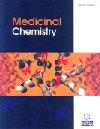Structure-Based Virtual Screening to Identify Negative Allosteric Modulators of NMDA.
IF 1.9
4区 医学
Q3 CHEMISTRY, MEDICINAL
引用次数: 2
Abstract
BACKGROUND NMDA(N-methyl-D-aspartate) Receptor is one of the ionotropic receptor sub types of Glutamate, the most abundant excitatory neurotransmitter in Human Brain. Besides physiological roles in learning and memory, neuronal plasticity and somatosensory function NMDA-R overstimulation is also implicated in a pathophysiological mechanism of 'excitotoxicity'. In this study, an allosteric site has been focused for designing inhibitors of the most abundant form of this receptor of utility in many acute (stroke, traumatic brain injury) and chronic neurodegenerative diseases such as Parkinson's disease, Huntington's, Alzheimer's, and others. METHODS Targeting this specific site at the interdimer interface of ligand binding domain of GluN2A containing NMDA-Rs and using pharmacophore based virtual screening, docking, computational ADME prediction techniques and MD simulation studies, blood brain barrier permeable potentially therapeutic compounds as opposed to only pharmacological tools currently available were sought. RESULTS Proceeding through the in-silico methodology, the study was successful at reaching to 5 compounds from ChEMBL Database which were predicted to be potential NMDA inhibitor drugs. CONCLUSION The product of the study are compounds which have been validated through pharmacophore and score-based screening and MD simulation techniques to be allosterically inhibiting NMDA receptors and with favorable pharmacokinetic profile are likely to be therapeutic agents ready for in-vitro and in-vivo testing.基于结构的虚拟筛选识别NMDA负变构调节剂。
nmda (n -甲基- d -天冬氨酸)受体是谷氨酸的一种嗜离子受体亚型,是人脑中最丰富的兴奋性神经递质。除了在学习和记忆方面的生理作用外,神经元可塑性和体感觉功能NMDA-R过度刺激也涉及“兴奋毒性”的病理生理机制。在这项研究中,一个变构位点被重点用于设计这种受体最丰富形式的抑制剂,这种受体在许多急性(中风、创伤性脑损伤)和慢性神经退行性疾病(如帕金森病、亨廷顿病、阿尔茨海默病等)中都有应用。方法针对GluN2A中含有NMDA-Rs的配体结合域的中间二聚体界面上的这一特定位点,利用基于药效团的虚拟筛选、对接、计算ADME预测技术和MD模拟研究,寻找可穿透血脑屏障的潜在治疗化合物,而不是目前仅有的药物工具。结果通过计算机方法,从ChEMBL数据库中筛选出5个候选的NMDA抑制药物。结论经药效团、评分筛选和MD模拟技术验证的化合物具有变构性抑制NMDA受体,具有良好的药代动力学特征,有望成为体外和体内试验的治疗药物。
本文章由计算机程序翻译,如有差异,请以英文原文为准。
求助全文
约1分钟内获得全文
求助全文
来源期刊

Medicinal Chemistry
医学-医药化学
CiteScore
4.30
自引率
4.30%
发文量
109
审稿时长
12 months
期刊介绍:
Aims & Scope
Medicinal Chemistry a peer-reviewed journal, aims to cover all the latest outstanding developments in medicinal chemistry and rational drug design. The journal publishes original research, mini-review articles and guest edited thematic issues covering recent research and developments in the field. Articles are published rapidly by taking full advantage of Internet technology for both the submission and peer review of manuscripts. Medicinal Chemistry is an essential journal for all involved in drug design and discovery.
 求助内容:
求助内容: 应助结果提醒方式:
应助结果提醒方式:


